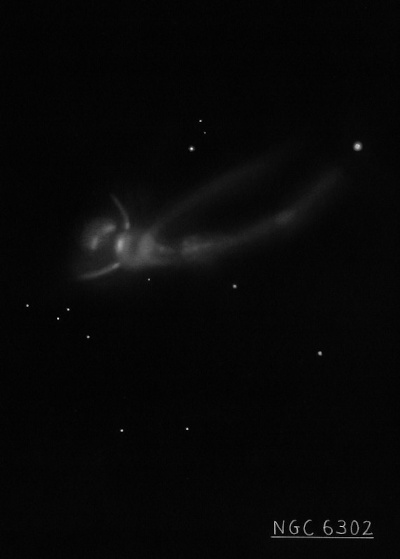Bug Nebula
Bug Nebula

E.E. Barnard discovered NGC 6302 in 1880 with his 5-inch refractor. He wrote, "A small flickering indefinite nebula slightly elongated (east and west) with 5-inch refractor." This was the first nebula that Barnard found, though the discovery was not published until 1884 (AN 108, 369 and Sidereal Messenger, Vol 2, p226). He noted "Prof. Swift, with his 16 inch refractor finds it to be a triple and elongated; its major axis nearly perpendicular to the meridian; a smaller nebula at each end, one of which is exceedingly faint. Its place is from one observation with the meridian circle." In 1892 Barnard made a detailed observation and sketch with the 36-inch refractor at Lick Observatory. As far as the popular nickname, Barnard commented, "from its singular appearance, I have called it the "Bug Nebula".
Dreyer noted "seems to be Dunlop 567 [found on 5 Jun 1826]" in the IC 1 Notes. Dunlop's description reads "a very faint small ill-defined nebula, with a small star in it, with two small stars south of it, but not involved." If this description applies to NGC 6302, his position was particularly bad -- 1.1° NE of the planetary. But Glen Cozens, in a 2010 article in the "Journal of Astronomical History and Heritage" states "D 567 is an asterism, not the planetary nebula NGC 6302, as suggested by Hartung." It's surprising the John Herschel missed this bright planetary during his sweeps.
200/250mm - 8" (6/27/81): fairly bright, small, elongated, bright core and brighter along the western extension.
300/350mm - 13.1" (7/27/84): structure highly suspected with the western extension cut by a dark lane. The eastern extension bends north following the core.
13.1" (7/5/83): bright, fairly small, elongated E-W, very high surface brightness. Subtle structure but the western extension is notably longer, brighter and possibly cut by a dark lane.
400/500mm - 17.5" (6/30/00): at 280x (unfiltered) the Bug Nebula is a remarkable, high surface brightness object, elongated 3:1 WSW-ENE, ~2.0x0.7'. The intensely bright 10" core appears elongated SW-NE and is offset to the east of center. A quasi-stellar nucleus sharpens to a stellar point when the seeing steadies (this is not the central star, though). The western wing is longer and is nearly split at the midpoint by a dark slash oriented N-S with a brighter condensation at the west end. The shorter eastern wing is more pinched and just past its midpoint there is a kink and it angles towards the SE.
900/1200mm - 48" (5/3/19): amazing view of the Bug Nebula at 375x! The central section was elongated roughly N-S and displayed an extremely high surface brightness. Four distinct "wings" were attached; two to the west and two to the east. A surprisingly long wing is on the southwest side. It has a noticeable bright section after dimming. The wing tapers and then fades, stretching to the WNW for a total length of near 2'! A mag 12 star is ~30" NW of the end of the wing. The lowest surface brightness wing is on the NW side and extends in the direction of the mag 12 star for about 1' in length, but extends ~1.5' with averted vision. The third extension on the southeast side is the narrowest and tapers at the east end. It appeared fairly uniform in surface brightness. Finally, the 4th and brightest wing is on the northeast side. It extends towards the ENE but curls to the SE forming the shape of a "pincher claw" with the southeast wing.
Notes by Steve Gottlieb